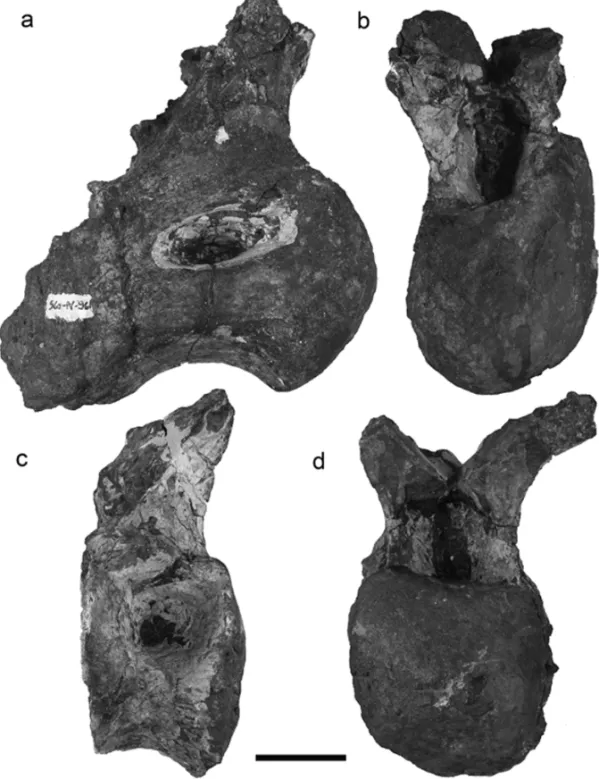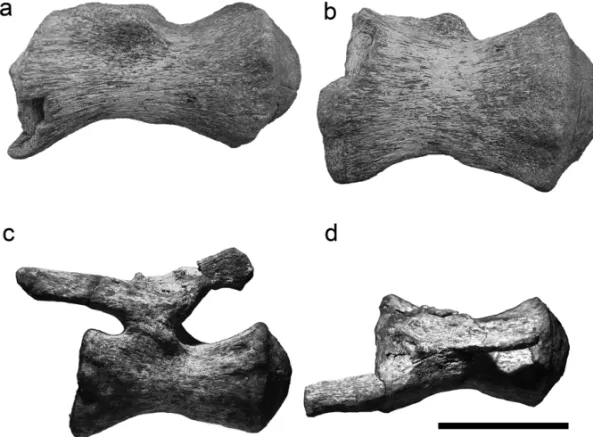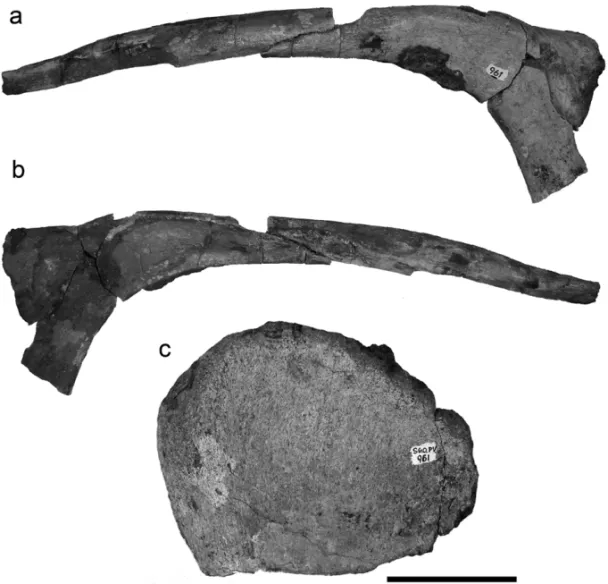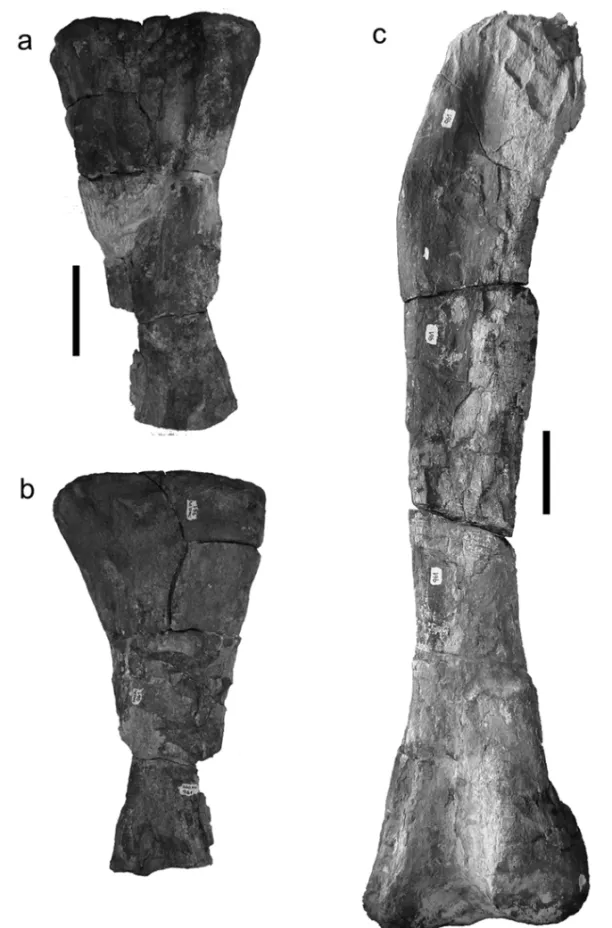(Annals of the Brazilian Academy of Sciences)
Printed version ISSN 0001-3765 / Online version ISSN 1678-2690 www.scielo.br/aabc
A new titanosaur sauropod from the Atacama Desert, Chile
ALEXANDER W.A. KELLNER1, DAVID RUBILAR-ROGERS2, ALEXANDER VARGAS3 and MARIO SUÁREZ4
1Setor de Paleovertebrados, Departamento de Geologia e Paleontologia, Museu Nacional/Universidade Federal do Rio de Janeiro, Quinta da Boa Vista s/n, São Cristóvão, 20940-040 Rio de Janeiro, RJ, Brasil
2Área Paleontología, Museo Nacional de Historia Natural, Casilla 787, Santiago, Chile
3Departamento de Biología, Facultad de Ciencias, Universidad de Chile, Las Palmeras 3425, Ñuñoa, Casilla 653, Santiago, Chile 4Museo Paleontológico de Caldera, Av. Wheelwrigth 001, Caldera, Chile
Manuscript received on December 22, 2010; accepted for publication on January 12, 2011
ABSTRACT
Partial remains of a titanosaur sauropod collected in the Tolar Formation (Upper Cretaceous) at the Atacama Desert (Antofagasta Region), northern Chile, is described, and a new species, Atacamatitan chilensisgen. et sp. nov., is erected. The material consists mainly of dorsal and caudal vertebrae, part of a humerus and a femur. The presence of a titanosaur confirms the Cretaceous age for the outcrops of red sandstone of the Tolar Formation whose age was previously uncertain, ranging from the Upper Cretaceous to the Paleocene. The new specimen represents the most complete dinosaur reported for this region and one of the most complete titanosaur known from Chile and the pacific margin of South America so far.
Key words:Dinosauria, Titanosauria,Atacamatitan, Atacama Desert, Cretaceous, Chile.
INTRODUCTION
The record of continental fossil vertebrates in Meso-zoic deposits of Chile is very rare. From these, although scarce, titanosaur sauropods are the best documented, mostly limited to incomplete and isolated remains re-covered from only four localities, all from the north-ern part of the country (Rubilar-Rogers 2003, 2005). They include the first report of non-avian dinosaur bones, consisting of an incomplete left scapula and coracoid, and the distal end of a right humerus that were regarded ascf. Antarctosaurs wichmannianusand as
Titanosauri-dae indet., respectively (Casamiquela et al. 1969). In order to prospect for continental Mesozoic tetra-pod fossils in Chile, contacts between Chilean and Brazilian researchers were established in 1998 and a preliminary expedition during February 2000 was orga-nized by the Museo Nacional de Historia Natural
(San-Proceedings of the Third Gondwanan Dinosaur Symposium Correspondence to: Alexander Wilhelm Armin Kellner E-mail: kellner@mn.ufrj.br
tiago) and the Museu Nacional/UFRJ (Rio de Janeiro) to the Antofagasta region. During this field activity, a site located about 150 km north of Calama town and some 50 km east from El Abra cooper mine was dis-covered (Vargas et al. 2000). The deposits in this area represent the Tolar Formation that consists of a sequence of sedimentary clastic red rocks with intercalations of conglomerates of the same color and brechas at the base (Maksaev 1978). Up to that time, the age inferred for this formation had not been defined with precision, rang-ing from the Upper Cretaceous to the Paleocene. The dinosaur specimen supports a Cretaceous age at least for the outcrops of the Tolar Formation near Conchi Viejo town, where the dinosaur site is located.
212 ALEXANDER W.A. KELLNER, DAVID RUBILAR-ROGERS, ALEXANDER VARGAS and MARIO SUÁREZ
a surface of 2 m2 and is regarded as representing one
individual, which is described here.
SYSTEMATIC PALEONTOLOGY
Dinosauria Owen, 1842 Sauropoda Marsh, 1878
Titanosauria Bonaparte & Coria, 1993 Titanosauriformes Salgado et al., 1997
Titanosauridae Lydekker, 1893
Atacamatitangen. nov.
Etymology: Atacama, from the desert where the spec-imen was found, and Titan, which relates to a group of Greek divinities.
Type species: Atacamatitan chilensissp. nov., type by monotypy.
Recorded temporal and stratigraphic range: Upper Cretaceous, Tolar Formation.
Diagnosis: As for the type and only known species.
Atacamatitan chilensissp. nov.
Etymology: In allusion to Chile, the country where the specimen was found.
Holotype: The material includes a right femur, the proximal end of a humerus, two dorsal vertebrae, pos-terior caudal vertebrae, dorsal ribs and a fragmentary element regarded as part of the sternum, besides other incomplete bones, all housed at the Sección Paleonto-logía, Museo Nacional de Historia Natural, under the number SGO-PV-961 (Figs. 1-4). A cast of one caudal vertebra (MN 7232-V) is deposited in the Museu Na-cional/UFRJ (Rio de Janeiro).
Occurrence: The material comes from an outcrop near Conchi Viejo town, Atacama Desert, Antofagasta Re-gion, and was collected in a surface of 2 m2.
Recorded temporal and stratigraphic range: Upper Cretaceous, Tolar Formation.
Diagnosis: Titanosaurid dinosaur with the following combination of characters that distinguishes it from other members of this clade (autapomorphies are marked with an asterisk): centrum of dorsal vertebrae pierced by pleurocoels, which are rounded or elliptical but do not
acuminate posteriorly*; ventral surface of the dorsal ver-tebra strongly concave*; posterior caudals with a lat-erally compressed neural spine that bears a blade-like anterior margin*; femur with the shaft getting gradually narrower until two thirds of its length*.
DESCRIPTION AND COMPARISONS
When the site was found, the first specimen of Ataca-matitan chilensisgen. et sp. nov. to be recognized was
the femur, which was eroding on the surface. Subse-quently, other bones were excavated, including several fragments. Some are slightly distorted due to taphon-omy, but their original shape can be established without difficulty. The bones have a reddish color and are quite heavy, a result of extensive permineralization.
Only two dorsal vertebrae were recovered. They are incomplete, with the neural arches only partially pre-served. Both are opisthocoelic, lacking hyposphene-hypantrum as in several members of the Titanosauridae (e.g., Salgado et al. 1997). In SGO-PV-961a (Figs. 1A, B) the centrum is remarkably opisthocoelic, with the an-terior articulation more convex in lateral view than in SGO-PV-961b. Also, in the former, the centrum is more elongated. It bears on the lateral side developed pleu-rocoels that are more rounded and less elongated com-pared with other titanosaurids. These pleurocoels do not acuminate posteriorly in the preserved elements of the new species, contrary to what is observed in several other members of this clade (e.g., Trigonosaurus, see
also Calvo et al. 2007b). The main axis of the pleuro-coel has 83 mm and occupies a dorsal position in the centrum. The neural arch is broken and only part of the peduncles is preserved. Their attachment to the centrum is longer than the total length of the pleurocoels. The centrodiapophyseal lamina is undivided. Together with the peduncles, this lamina is inclined anteriorly.
Judging from the preserved portion, the neural arch is wider than high. There is no evidence of the para-pophyses at the centrum or at the lower portion of the neural arch indicating that this is a middle or posterior dorsal vertebra. The ventral margin of the centrum is concave. Posteriorly, the centrum bears a pronounced excavation.
The second preserved dorsal vertebra of
antero-Fig. 1 –Atacamatitan chilensisgen. et sp. nov., lateral and anterior views of dorsal vertebrae of SGO.PV. 961a (A, B) and SGO-PV-961b (C,D). Scale bars: 50 mm.
posteriorly compressed. The neural arch is not complete and only the peduncles, the prezygapophyses and part of the left diapophysis are preserved. The base of the peduncles is long and covers almost the total length of the centrum. There is little distance between both prezy-gapophyses, forming, in anterior view, an angle of ap-proximately 35◦. Part of the prezygapophyseal lamina is preserved in the left prezygapophysis. There is no evidence of parapophyses situated on the centrum or
214 ALEXANDER W.A. KELLNER, DAVID RUBILAR-ROGERS, ALEXANDER VARGAS and MARIO SUÁREZ
Comparing the dorsal vertebrae of Atacamatitan chilensis with other titanosaurids, they differ from Trigonosaurus, Gondwanatitan, Uberabatitan and Sal-tasaurus by the strongly concave ventral margin of the
centrum, for all in SGO-PV-961a (Powell 1992, Kellner and Azevedo 1999, Campos et al. 2005, Salgado and Carvalho 2008). In this respect, there are similari-ties withMuyelensaurus,Mendozasaurusand, to some
extent, with Opisthocoelicaudia (Salgado et al. 1997,
González Riga 2003, Calvo et al. 2007b). Judging from the two preserved dorsal elements, Atacamatitan chi-lensis differs by having the pleurocoels comparatively
more rounded and less elongated that do not acuminate posteriorly.
Some caudal elements were recovered, but only two are preserved well enough to provide anatomical de-tails. Both come from the middle to posterior end of the tail. SGO-PV-961c (Fig. 2A, B) is essentially formed by the centrum. It is procoelous, compressed dorsoventrally and lacks pleurocoels. Remains of the left transverse process and the base of the neural arch can be observed. No chevrons were collected at the site, but the centrum bears two strong processes to receive them. The ventral and lateral surfaces of the centrum are slightly curved. In dorsal view it is possible to observe a deep compression in the middle portion of this element.
The second caudal element (SGO-PV-961h; Figs. 2C, D) is complete, lacking only the right prezygapoph-ysis. Overall the centrum (length: 86 mm) shows a sim-ilar morphology to the previous one (SGO-PV-961c). It is smaller and was positioned more posteriorly than the first. The posterior articulation surface is quadrangu-lar and no processes to receive the chevron are present. It shows a very small dorsal tuberosity on the lateral side of the centrum (sensu Kellner et al. 2005). The prezygapophyses are elongated and reach about 30% of the preceding vertebral centrum. Postzygapophyses are short and located at the ventral margin of the neural spine. The neural arch is placed in the anterior half of the centrum. The neural spine is directed posterodorsally and has the distal tip slightly expanded dorsoventrally.
Most anatomical information regarding caudal ver-tebrae of titanosaurid sauropods used in systematic stud-ies comes from the anterior or middle elements of the tail, and the preserved elements of Atacamatitan
chilen-sisare from the middle-posterior portion of the caudal
series. Nonetheless, a few differences from other ti-tanosaurid caudal vertebrae are noted. The most dis-tinct posterior caudals in titanosaurids are found in Salta-saurusandRocasaurus, with quite large and developed
postzygapophyseal articulations and a longitudinal sep-tum on the ventral part of the vertebrae (Powell 1992, Salgado and Azpilicueta 2000), absent inAtacamatitan.
The new Chilean species also differs from the less pro-coelic condition found in the posterior caudals of Mala-wisaurus(Jacobs et al. 1993), a taxon that occupies a
more basal position within the Titanosauria (e.g., Sal-gado et al. 1997, Calvo et al. 2007b).
Although the caudals ofAtacamatitanprobably are
more posterior than the most posterior caudal of Trigo-nosaurus, in the new taxon they differ by being more procoelic (Campos et al. 2005). The last preserved cau-dal ofBaurutitan(the 18th) can be distinguished from
the more complete element of the Chilean titanosaurid (which might also be more posterior) by having a distinct process on the neural spine, which is also quite elongated anteroposteriorly (Kellner et al. 2005). Mendozasaurus
andMuyelensaurus also have distinct neural spines in
their preserved posterior caudal elements that are higher and more elongated anteroposteriorly than in Atacama-titan (González Riga 2003, Calvo et al. 2007a). The preserved posterior caudal vertebrae ofGondwanatitan
show a straighter ventral margin (Kellner and Azevedo 1999), contrasting with the concave condition observed in Atacamatitan. Furthermore, this Brazilian
titanosau-rid has a broader and more inclined neural spine. The most similar caudal elements of the Chilean species are found inMaxakalisaurusandUberabatitan
(Kellner et al. 2006, Salgado and Carvalho 2008). The main difference is the less developed neural spine in
Atacamatitan that has a sharp and blade-like anterior
margin. Comparisons with some other South American titanosaurids that are based on caudal elements such as
Adamantisaurusare very limited, since there is no
over-lapping element (Santucci and Bertini 2006).
Fig. 2 –Atacamatitan chilensisgen. et sp. nov., caudal centrum SGO.PV.961c in ventral (A) and ventrolateral views (B); caudal vertebrae SGO-PV-961h in lateral (C) and dorsal (D) views. Scale bars: 50 mm.
ventral side with a crest that forms a marked angle (about 90◦) on the dorsal edge. The capitulum and tuberculum are not complete. It is unknown if the ribs of Atacamati-tanalso bear pneumatic foramina as observed in some
other titanosaurids (e.g.,Maxakalisaurus).
A fragment of a plate-like bone is interpreted as a portion of the sternal plate (SGO-PV-961e, Fig. 3C). It is thin with a smooth border. Given the fragmentary condition, it is impossible to distinguish if the element corresponds to a crescentic or oval general form (Salgado et al. 1997).
The proximal half of a right humerus (Figs. 4A, B) is preserved (SGO-PV-961f). The proximal end is ex-panded and has a square outline. Although the deltopec-toral crest is not totally preserved, it is noticeable that this element has a reduced distal expansion. In anterior view, the humerus is hollowed out with a well-marked depression for muscular attachment. The midshaft is straight and has an elliptic transverse section. Although comparisons with other titanosaurids are rather limited, the humerus ofAtacamatitanbelongs to the elongated
type, differing from the shorter and blunter condition observed in Saltasaurus(Powell 1992). It further
dif-fers fromMendozasaurus, which bears a quite distinctive
and elongated deltopectoral crest (González Riga 2003). Also inGondwanatitanthe deltopectoral crest is larger
than in the comparable preserved portion of Atacamati-tan(Kellner and Azevedo 1999).
216 ALEXANDER W.A. KELLNER, DAVID RUBILAR-ROGERS, ALEXANDER VARGAS and MARIO SUÁREZ
Fig. 3 –Atacamatitan chilensisgen. et sp. nov., rib (SGO-PV-961d) in anterior (A) and posterior (B) views; fragmentary sternal plate (SGO-PV-961e). Scale bar: 100 mm.
along the shaft is variable and smaller than the width between the external surface of the distal condyles. On the distal end, the fibular and tibial condyles are of sube-qual sizes, with the medial one slightly larger. A well-developed fourth trochanter in present posteriorly, ex-tending onto the proximal quarter of the femur. A deep groove runs along the proximal third of the femur and is positioned medial to the greater trochanter. The posterior surface of the distal end of the femur shows a depression that gently separates the medial and lateral condyles.
DISCUSSION
As pointed out innumerous times in the literature, the recognition of species in the fossil record can be a com-plex endeavor (see discussion in Kellner 2010). In sev-eral cases, a new species is based on incomplete ma-terial, which is also the case for titanosaurid sauropods
(e.g., Salgado and Azpilicueta 2000, Mateus et al. 2011). Regarding this group, most of the specimens tend to be very incomplete and fragmentary (e.g., Kellner and Cam-pos 1999, 2000). This is also the case ofAtacamatitan chilensis, known for a limited number of elements.
ti-Fig. 4 –Atacamatitan chilensisgen. et sp. nov., proximal half of right humerus (SGO-PV-961f) in anterior (A) and posterior (B) views; femur in anterior view (C) Scale bar: 100 mm.
tanosaurids. Furthermore, the strongly concave ventral surface of the dorsal vertebra indicates that this material belongs to a new titanosaurid species. This is corrobo-rated by the almost complete posterior caudal element
that has a laterally compressed neural spine with a sharp and blade-like anterior margin.
The humerus ofAtacamatitan chilensishas a poor
de-218 ALEXANDER W.A. KELLNER, DAVID RUBILAR-ROGERS, ALEXANDER VARGAS and MARIO SUÁREZ
rived titanosaurids such asGondwanatitan, Opisthocoe-licaudia, Saltasaurus, NeuquensaurusandAlamosaurus,
whose deltopectoral crest is markedly expanded distally. Such condition is mentioned as a synapomorphy of Sal-tasauridae by Wilson (2002, but see Salgado et al. 1997). Another element that shows some distinction from other titanosaurids is the femur, which inAtacamatitan chilensishas a shaft that gets narrower until two thirds
of its length.
Although the systematic position of Atacamatitan chilensisis difficult to be established (which is also the
case for most titanosaurids), at the time being we can state that this new form is more basal relative to the Saltasauridae, but more derived relativeMalawisaurus,
and is not a member of the Aeolosaurini.
There is another titanosaurid from the Cretaceous deposits of the Atacama region in Chile. However, the geographic distance (also an aspect to be considered in the recognition of new species – see Kellner 2010) of these records (more than 1.000 km) and some discrete anatomical differences (D. Rubilar-Rogers et al., unpub-lished data) make it unlikely that these specimens repre-sent the same species.
CONCLUSIONS
Despite the fragmentary and incomplete condition of the specimen SGO-PV-961, it is one of the most com-plete dinosaur recorded in Chile and does represent a new species, named hereAtacamatitan chilensisgen. et
sp. nov. The new taxon occupies an intermediate posi-tion regarding the Titanosauridae, being less derived than the Saltasauridae but more derived thanMalawisaurus.
This material confirms the Cretaceous age of the Tolar Formation and shows that these deposits have potential for new findings.
ACKNOWLEDGMENTS
The authors express their gratitude to Diogenes de Almeida Campos (Museu de Ciências da Terra, Rio de Janeiro) and Jorge O. Calvo (Universidad Nacional del Comahue, Centro Paleontológico Lago Barreales, Neu-quén) for allowing the examination of the specimen under their care. We also thank Helder de Paula Silva (Universidade do Grande Rio, Duque de Caxias) for his help during the second field season at the Atacama Desert
and for preparing the second caudal vertebra (SGO-PV-961h), and Carolina Simon Gutstein for the edition and photographic work. Agustín G. Martinelli (Complexo Cultural e Científico Peirópolis – CCCP/UFTM, Ube-raba), Octávio Mateus (Faculdade de Ciências e Tec-nologia, Universidade Nova de Lisboa, Portugal) and two anonymous reviewers are thanked for comments that greatly improved this paper.
This study was partially funded by the Fundação Carlos Chagas Filho de Amparo à Pesquisa do Estado do Rio de Janeiro (FAPERJ no. E-26/102.779/2008) and the Conselho Nacional de Desenvolvimento Científico e Tecnológico (CNPq no. 307276/2009-0) (grants to AWAK) and Conicyt (grant to DRR).
RESUMO
Um esqueleto incompleto de um dinossauro titanossaurídeo de depósitos da Formação Tolar (Cretáceo Superior) do deserto do Atacama (região de Antofagasta), norte do Chile é descrito e uma nova espécie,Atacamatitan chilensisgen. et sp. nov., é proposta. O material consiste principalmente de vértebras dorsais e caudais e de partes do úmero e fêmur. A presença de um titanossauro confirma a idade Cretácea para os afloramentos de arenito avermelhado da Formação Tolar, que eram anterior-mente tidos como depositados entre o Cretáceo Superior e o Paleoceno. O exemplar representa o mais completo titanos-sauro até hoje encontrado na região e um dos mais completos reportados até o momento do Chile e da margem do Oceano Pacífico na América do Sul.
Palavras-chave: Dinosauria, Titanosauria, Atacamatitan, Deserto do Atacama, Cretáceo, Chile.
REFERENCES
CALVOJO, PORFIRIJDANDGONZÁLEZ-RIGA B. 2007a. A new titanosaur sauropod from the Late Cretaceous of Neuquén, Patagonia, Argentina. Arq Mus Nac 65: 485– 504.
CALVOJO, PORFIRIJD, GONZÁLEZ-RIGABANDKELL -NERAWA. 2007b. A new Cretaceous terrestrial ecosys-tem from Gondwana with the description of a new sauro-pod dinosaur. An Acad Bras Cienc 79: 529–541. CAMPOS DA, KELLNER AWA, BERTINI RJ AND SAN
CASAMIQUELA RM, CORVALÁN J AND FRANQUESA F. 1969. Hallazgo de dinosaurios en el Cretácico Superior de Chile. Su importancia cronológica – estratigráfica. Insti-tuto de Investigaciones Geológicas, Boletín 25: 1–31. GONZÁLEZRIGABJ. 2003. A new titanosaur (Dinosauria,
Sauropoda) from the Upper Cretaceous of Mendoza Province, Argentina. Ameghiniana 40: 155–172. JACOBS LL, WINKLER DA, DOWNS WR AND GOMANI
EM. 1993. New material of an early Cretaceous titano-saurid sauropod from Malawi. Palaeontology 36: 523– 534.
KELLNER AWA. 2010. Comments on the Pteranodontidae (Pterosauria, Pterodactyloidea) with the description of two new species. An Acad Bras Cienc 82: 1063–1084. KELLNERAWAANDAZEVEDOSAK. 1999. A new
sauro-pod dinosaur (Titanosauria) from the Late Cretaceous of Brazil. National Sciences Museum Monographs 15: 111– 142.
KELLNERAWAANDCAMPOSDA. 1999. Vertebrate Pale-ontology in Brazil – a review. Episodes 22: 238–251. KELLNERAWAANDCAMPOSDA. 2000. Brief review of
dinosaur studies and perspectives in Brazil. An Acad Bras Cienc 72: 509–538.
KELLNER AWA, CAMPOSDA, AZEVEDO SAK, TROTTA MNF, HENRIQUESDDR, CRAIKMMTANDSILVAHP. 2006. On a new titanosaur sauropod from the Bauru Group, Late Cretaceous of Brazil. Bol Mus Nac, Geol 74: 1–31.
KELLNER AWA, CAMPOSDAANDTROTTAMNF. 2005. Description of a titanosaurid caudal series from the Bauru Group, late Cretaceous of Brazil. Arq Mus Nac 63: 529– 564.
MAKSAEVV. 1978. Cuadrángulo Chitigua y sector occidental del cuadrángulo Cerro Palpana, Región de Antofagasta. Carta Geológica de Chile n◦31, 55 p. 1 mapa 1: 50.000. Instituto de Investigaciones Geológicas.
MATEUSO, JACOBSLL, SCHULPAS, POLCYNMJ, TAVA -RESTS, NETOAB, MORAISMLANDANTUNESMT. 2011. Angolatitan adamastor, a new sauropod dinosaur and the first record from Angola. An Acad Bras Cienc 83: 221–233.
MCINTOSHJS. 1990. Sauropoda. In: The Dinosauria (WEIS -HAMPELD, DOBSONPANDOSMOLSKAH (Eds), Uni-versity of California Press, Berkeley, p. 345–401. POWELL JE. 1992. Osteología de Saltasaurus loricatus
(Sauropoda – Titanosauridae) del Cretácico Superior del Noroeste argentino. In: SANZ JL YBUSCALIONIAD (Coords), Los Dinosaurios y su entorno biotico. Actas del Segundo Curso de Paleontologia en Cuenca. Ayun-tamiento de Cuenca: Instituto “Juan de Valdes”, p. 165– 230.
RUBILAR-ROGERS D. 2003. Registro de dinosaurios en Chile. Boletín del Museo Nacional de Historia Natural 52: 137–150.
RUBILAR-ROGERSD. 2005. Titanosauriformes remains from Quebrada Cortadera (Tolar Formation, Upper Cretaceous), Atacama Desert, Chile. XXI Jornadas Argentinas de Pa-leontología de Vertebrados, Plaza Huincul, 38 p. SALGADOL ANDAZPILICUETA C. 2000. Un nuevo
salta-saurino (Sauropoda, Titanosauridae) de la provincia de Río Negro (Formación Allen, Cretácico Superior), Patagonia, Argentina. Ameghiniana 37: 259–264.
SALGADOLANDCARVALHOIS. 2008.Uberabatitan ribei-roi, a new titanosaur from the Marília Formation (Bauru Group, Upper Cretaceous), Minas Gerais, Brazil. Palae-ontology 51: 881–901.
SALGADOL, CORIARAANDCALVOJ. 1997. Evolution of titanosaurid sauropods. I: phylogenetic analysis based on the postcranial evidence. Ameghiniana 34: 3–32. SANTUCCI RMANDBERTINIR. 2006. A new titanosaur
from Western São Paulo State, Upper Cretaceous Bauru Group, South-East Brazil. Palaeontology 49: 59–66. VARGASA, KELLNERAWA, DIAZGC, RUBILARDAND
SOARESM. 2000. New sauropod dinosaur from the Ata-cama desert, northern Chile. J Vert Paleont 20(Suppl. 3): 75A.



